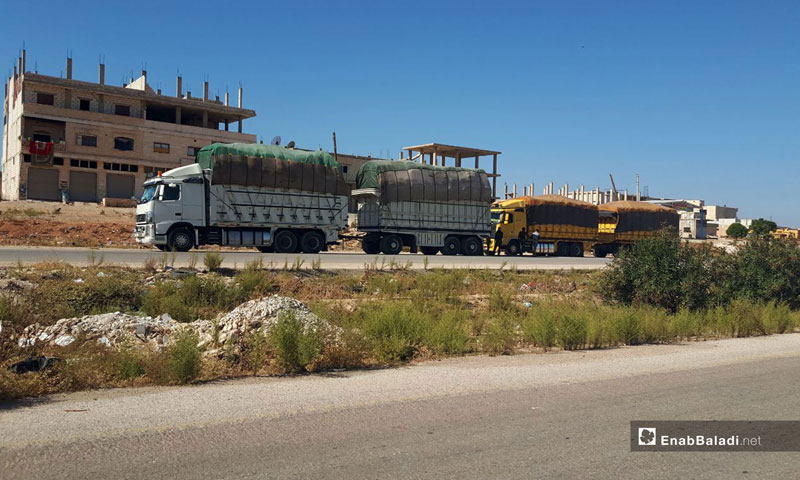



Two angles shape Russia’s view of the “Hay’at Tahrir al-Sham” (HTS). The first is “terrorism,” which necessitates fighting it in all the areas it controls, the last of which is Idlib. The second is “interest” and all that relates to it, whether at the military level, the evacuation of the areas it controls under planned deals, or at the economic level, which affects both sides.
Since the beginning of its military intervention in Syria, 2015, Russia directed its military operations at the “Tahrir al-Sham” and created a pretext out of it in all the areas controlled by the Syrian opposition; it additionally eliminated the “Tahrir al-Sham” from all the political treaties. However, at the same time, Russia did not stop its undeclared communication with the faction, which is a beneficial step, on the ground basically.
The latest of the developments that marked the relationship between the two sides was opening the Murak crossing in northern rural Hama, three moths after it was shut down, taking into consideration the massive military reinforcements called in by the Assad’s forces to the governorate’s surrounding back then.
Russia did not comment on the nature of the deal with the “Tahrir al-Sham” and did not announce it; the “Tahrir al-Sham” followed a similar approach, even though all the indicators stress continuity of the communication between the two parties’ in the past a few days, which so far ended up with the reopening of the crossing, which will benefit both sides at an economic level, for it is considered one of the financial resources of the “Tahrir all-Sham,” while Russia offers the crossing to the Syrian regime, as an outlet to the north to pass commodities and commercial goods.
Following the reopening of the Murak crossing, November2, the “Government of Salvation” issued a statement justifying the step it undertook and added that “it came as to alleviate the burden of our people in the liberated areas and a continuation of the security and military efforts done around the clock.”
The “Government,” accused of affiliation to the “Tahrir al-Sham,” added that the crossing was opened as to serve the revival of the economic movement and raise its level in the liberated areas,” pointing out to “the efforts made by the economic office in rural Hama for opening the crossing.”
The justifications offered by the “Salvation Government” followed the accusations directed at the “Tahrir al-Sham” concerning its deal with Russia, despite the enmity it shows to the Russians and its constant calls for the necessity to continue with the military operations, regardless of the deals, Astana and others.
Upon contacting the “Tahrir al-Sham,” it refuted direct communications with Russia, and Imad al-Deen Mujahid, director of the Public Relations Department, told Enab Baladi that the reopening of the crossing is the specialty of the “Salvation Government,” which could be translated as a step to push the “Tahrir al-Sham” from the scene and link the issue to the “Salvation Government,” presented as a civic government, pure of militarization.
Military sources in Murak told Enab Baladi, a day before the reopening of the crossing, that the process was conducted under a deal between the “Tahrir al-Sham” and Russia, which was not officially declared. The sources explained that the Russian police has in the past a few days removed the dust mounds blocking the crossing at the side of the Syrian regime to allow the passage of trucks loaded with commodities.
The “Tahrir al-sham” runs the Murak crossing, which it opened with areas controlled by the Syrian regime, in November 2017, after it controlled the village of Abu Dali, eastern Hama, which rapidly went back to the Assad’s forces’ grip. The crossing is part of the demilitarized area, with a width of 20 kilometers, along the confrontation lines between the opposition and the Syrian regime.
At the other side, the Russians did not cut their accusations against the “Tahrir al-Sham” of its attempt at failing the Idlib deal and the preparation to attack the Syrian regime or launching chemical attacks.
During talks about the start of the two sides’ negotiations concerning the Murak crossing, the Director of the Russian Reconciliation Center Vladimir Savchenko declared that “terrorists delivered two containers with chlorine to the town of Qalaat al-Madiq, some 20 km west of the city of Hama. The militants plan to use the poisonous substance to stage the use of chemical weapons against civilians by the Syrian government troops.”
These accusations were not the first, for the “al-Nusra Front,” today part of the “Tahrir al-Sham,” has always been accused of conducting provocations against the Assad’s forces in Idlib’s outskirts and the Russian forces in rural Lattakia.
From another standing point, the relationship between Russia and the “Tahrir al-Sham” in Northern Syria is not limited to the reopening of the Murak crossing, for there is also the al-Eiss crossing, southern rural Aleppo, which was reopened last year under a deal between Russia and the “Tahrir al-sham, on the condition that commodities and commercial materials pass through it, as well as civilians.
In a former interview with Enab Baladi, Abbass Sharifah, researcher specialized with the affairs of Jihadist groups, said that the only thing that is, today, igniting the policy of the “Tahrir al-Sham” is not “ideology” but “pragmatism” and maneuvering as to gain benefits, pointing out that “ideology” has weakened a lot after seven years from the Syrian revolution, and, to a certain extent, it “cooled off.”
The interests that the “Tahrir al-Sham” is seeking, its General Commander “Abu Mohammad al-Julani” in particular, are power, influence and “preserving hegemony,” to which he referred in all his video speeches and the last of which was released in August 2018.
if you think the article contain wrong information or you have additional details Send Correction